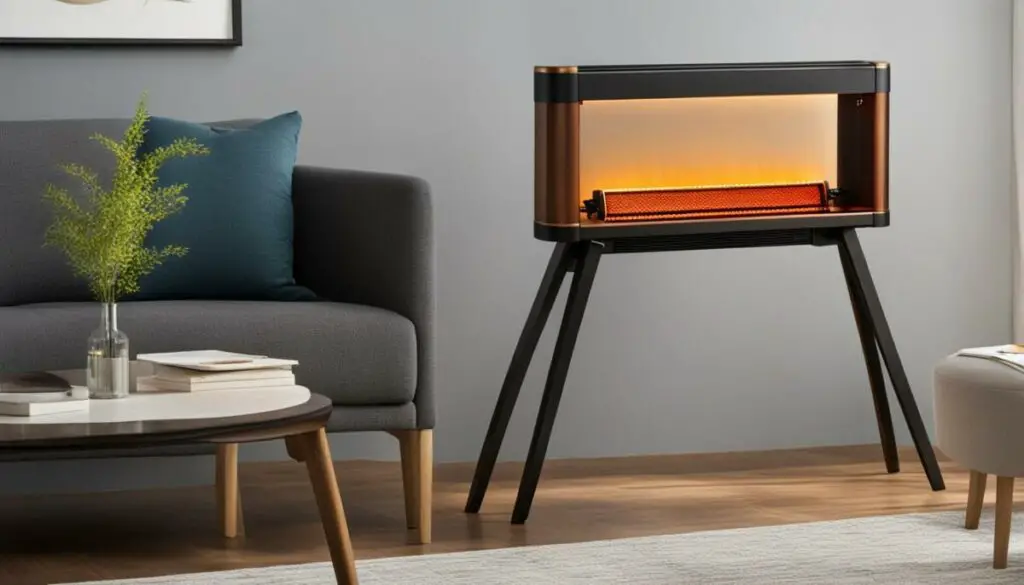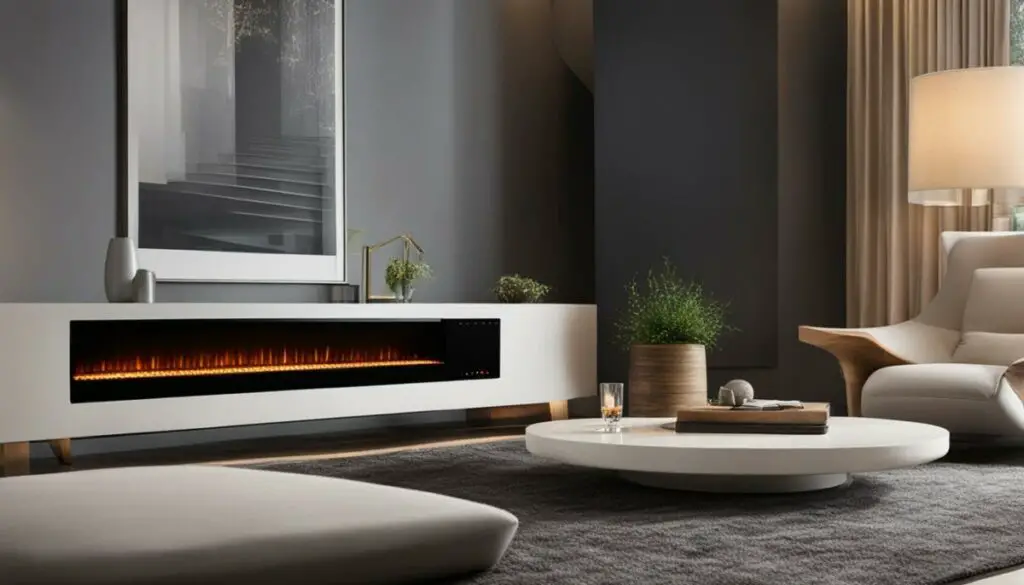Last Updated on 5 months by Francis
Infrared heaters and ceramic heaters are two popular options for heating homes. If you’re in the market for a new heater, you may be wondering which type is better. In this article, we will compare the features and benefits of infrared heaters and ceramic heaters, helping you make an informed decision.
Contents
Key Takeaways:
- Infrared heaters use carbon heating elements for even and deep heat distribution.
- They offer higher detoxification and a cleaner sweat due to longer wavelengths.
- Ceramic heaters have a lower initial cost and provide concentrated heat.
- Both types of heaters have advantages and can be used in combination for optimal results.
- Consider factors such as health benefits, energy efficiency, and budget when choosing the right heater for your home.
Health Benefits of Infrared Heaters

Infrared heaters offer numerous health benefits, making them a popular choice for home heating. The unique properties of infrared heat contribute to its positive impact on our well-being. Compared to ceramic heaters, which provide forced heat, infrared heaters emit longer wavelengths and operate at lower temperatures. These factors result in deeper heat penetration into the skin, promoting higher detoxification and a cleaner sweat.
The deep heat provided by infrared heaters has been associated with several health improvements. One notable benefit is improved blood circulation, which can help ease muscle tension and promote faster recovery from physical exertion. Infrared heat is also believed to alleviate certain respiratory issues, providing relief for individuals suffering from conditions such as asthma or allergies.
In addition to its physiological benefits, infrared heat offers a gentle and natural warmth that can promote relaxation and stress reduction. Many people find the radiant heat emitted by infrared heaters to be soothing and therapeutic, creating a calming environment ideal for meditation or unwinding after a long day.
“Infrared heat therapy has shown great promise in improving blood circulation and relieving muscle tension. Its ability to provide deep heat penetration into the skin sets it apart from ceramic heaters, making it a preferred choice for individuals seeking both comfort and health benefits.” – Dr. Jane Roberts, Wellness Expert
To further explore the health benefits of infrared heaters, let’s take a look at the following table:
| Health Benefit | Infrared Heaters | Ceramic Heaters |
|---|---|---|
| Deep heat penetration | ✓ | x |
| Improved blood circulation | ✓ | x |
| Alleviates respiratory issues | ✓ | x |
| Promotes relaxation | ✓ | x |
As you can see from the table, infrared heaters excel in providing the health benefits discussed above, setting them apart from ceramic heaters.
Energy Efficiency and Cost Savings of Infrared Heaters
When it comes to energy efficiency and cost savings, infrared heaters have a distinct advantage over ceramic heaters. The modern technology used in carbon heaters, which are commonly found in infrared saunas, allows them to achieve necessary results at lower surface temperatures. This means that infrared heaters consume less energy compared to ceramic heaters while still providing efficient and effective heat distribution. In addition, infrared heaters reach the desired temperatures faster, resulting in shorter startup times and ultimately reducing energy consumption and costs in the long run.
Not only are infrared heaters more energy efficient, but they also tend to last longer than ceramic heaters. The carbon sheet construction of infrared heaters makes them exceptionally durable, even at high temperatures. On average, carbon heaters can last around 50,000 to 100,000 hours of usage, while ceramic heaters typically have a lifespan of only about 5,000 hours before becoming brittle and less efficient. The longevity of infrared heaters contributes to their overall energy efficiency and provides better value for money.
To visually showcase the energy efficiency and cost savings of infrared heaters compared to ceramic heaters, let’s take a look at the following table:
| Infrared Heaters | Ceramic Heaters | |
|---|---|---|
| Energy Consumption | Lower | Higher |
| Heat Distribution | Even and efficient | Variable and less efficient |
| Startup Time | Shorter | Longer |
| Lifespan | Longer (50,000-100,000 hours) | Shorter (around 5,000 hours) |
As shown in the table, infrared heaters outperform ceramic heaters in terms of energy consumption, heat distribution, startup time, and lifespan. These factors contribute to the energy efficiency and cost savings that make infrared heaters a compelling choice for homeowners looking to optimize their heating solutions.
Reliability and Durability of Infrared Heaters

When it comes to reliability and durability, infrared heaters have a clear advantage over ceramic heaters. Ceramic material tends to crack and fall apart over time, while carbon heaters made of carbon sheet are exceptionally durable, even at high temperatures. This makes infrared heaters a more long-lasting option, providing peace of mind and cost savings in the long run.
Carbon heaters, which are used in infrared saunas, are built to withstand the demands of frequent use and high heat. They typically have an average usage life of around 50,000-100,000 hours, while ceramic heaters only last around 5,000 hours before becoming brittle. This means that infrared heaters offer reliable heating performance for extended periods, making them a wise investment for those seeking a durable heating solution.
Additionally, the durability of carbon heaters translates into better efficiency over time. With their robust construction, infrared heaters are less prone to malfunctioning or degradation, ensuring consistent and effective heat distribution throughout their lifespan. Whether used in residential or commercial settings, infrared heaters are built to withstand the test of time and provide reliable warmth when needed.
Comparison Table: Reliability and Durability
| Infrared Heaters | Ceramic Heaters | |
|---|---|---|
| Material | Carbon sheet | Ceramic |
| Average Usage Life | 50,000-100,000 hours | 5,000 hours |
| Resistance to High Temperatures | Excellent | Brittle and prone to cracking |
| Longevity | Highly durable | Less durable |
Infrared heaters provide a reliable and durable heating solution, thanks to their carbon sheet construction. With an average usage life of 50,000-100,000 hours, they far surpass the longevity of ceramic heaters, which typically last around 5,000 hours. The robustness of infrared heaters ensures consistent performance and efficient heat distribution, making them a wise investment for long-term use.
How Ceramic Heaters Work and Their Benefits

When it comes to heating your home, ceramic heaters are a popular choice due to their efficiency and affordability. These heaters utilize a ceramic heating element to generate heat, which is then passed over the element and distributed into the room. This process allows ceramic heaters to provide rapid and concentrated heat, making them suitable for spot-treating specific areas.
One of the key advantages of ceramic heaters is their portability. They are typically lightweight and compact, making them easy to move and position in different areas of your home. Whether you need to warm up your bedroom, living room, or home office, a ceramic heater can be conveniently placed wherever it is needed most.
Additionally, ceramic heaters are known for their energy efficiency. The ceramic heating element heats up quickly, allowing the heater to reach its desired temperature faster. This not only saves you time but also reduces energy consumption and lowers your utility bills. With ceramic heaters, you can enjoy the warmth and comfort you desire without breaking the bank.
The Benefits of Ceramic Heaters:
- Portability: Lightweight and compact for easy transportation and positioning.
- Rapid Heating: Provides quick and concentrated heat for immediate warmth.
- Energy Efficiency: Reaches desired temperature quickly, saving energy and reducing utility costs.
“Ceramic heaters offer a cost-effective and convenient heating solution for your home. With their portability, rapid heating capabilities, and energy efficiency, ceramic heaters are a reliable choice for keeping your space warm and cozy.”
Even Heat Distribution and Energy Efficiency of Ceramic Heaters

One of the advantages of ceramic heaters is their ability to provide even heat distribution. Unlike traditional heaters that may result in uneven heating, ceramic heaters excel at delivering uniform warmth across the room. This is achieved through the use of a ceramic heating element that effectively disperses heat throughout the space, ensuring that every corner is comfortably heated.
In addition to their even heat distribution, ceramic heaters also offer high energy efficiency. These heaters generate heat quickly and efficiently, allowing them to warm up small spaces in a short amount of time. This means that they require less energy to operate, resulting in cost savings on your energy bills. With their energy efficiency, ceramic heaters provide an effective heating solution while minimizing energy waste.
To illustrate the energy efficiency of ceramic heaters, let’s take a look at the following table:
| Ceramic Heater | Infrared Heater | |
|---|---|---|
| Energy Consumption | Low | Medium |
| Heat-up Time | Quick | Slow |
| Even Heat Distribution | Yes | No |
As shown in the table, ceramic heaters have low energy consumption and a quick heat-up time compared to infrared heaters. They also provide even heat distribution, ensuring that every part of the room is warmed effectively. This combination of energy efficiency and even heat distribution makes ceramic heaters an excellent choice for heating small spaces in an efficient and cost-effective manner.
Safety Considerations and Tips for Infrared Heaters
When using infrared heaters, it’s important to prioritize safety to ensure their effective and safe operation. Here are some essential considerations and tips to keep in mind:
1. Proper Placement:
Strategically place the infrared heater to ensure optimal heat distribution and avoid any obstructions that may impede the flow of radiant heat. Keep in mind that objects, furniture, or curtains placed too close to the heater can pose a fire hazard. Maintain a safe distance between the heater and any combustible materials.
2. Regular Maintenance:
Perform routine maintenance on your infrared heater to keep it clean and operating efficiently. Dust or debris buildup on the heating element can impact its performance and potentially compromise safety. Refer to the manufacturer’s guidelines for specific cleaning instructions to ensure you’re maintaining the heater properly.
3. Select Heaters with Built-in Safety Features:
When purchasing an infrared heater, look for models that come with built-in safety features such as tip-over protection and overheat protection. These safeguards automatically shut off the heater if it gets knocked over or reaches unsafe temperatures, reducing the risk of accidents and fire hazards.
“Proper placement and regular maintenance are crucial for safe and efficient use of infrared heaters.”
By following these safety considerations and tips, you can enjoy the benefits of infrared heaters while minimizing potential risks. Remember to always prioritize safety and adhere to the manufacturer’s instructions for safe use and maintenance of your infrared heater.
| Safety Tips for Infrared Heaters |
|---|
| Proper Placement |
| Regular Maintenance |
| Select Heaters with Built-in Safety Features |
Safety Considerations and Tips for Ceramic Heaters
When it comes to using ceramic heaters, it is important to prioritize safety to prevent any accidents or hazards. By following a few key considerations and tips, you can enjoy the benefits of ceramic heaters while keeping your home and loved ones safe.
Proper Placement for Maximum Safety
One of the most crucial aspects of using ceramic heaters safely is ensuring proper placement. It is essential to keep the heater away from any flammable materials such as curtains, furniture, or bedding. Make sure there is at least a three-foot clearance around the heater to prevent any potential fire hazards. Additionally, avoid placing the heater in high-traffic areas or where it can be easily bumped into, as this could lead to accidental tip-over.
Regular Maintenance for Optimal Performance
Maintaining your ceramic heater regularly is vital for its safe and efficient operation. Start by dusting the heater regularly to prevent any accumulation of dust or debris that can interfere with its performance. Additionally, inspect the heater for any signs of wear and tear, such as frayed cords or cracked components. If any issues are detected, it is crucial to address them immediately by either repairing or replacing the heater to ensure its safe use.
Selecting Ceramic Heaters with Safety Features
When buying a ceramic heater, it is essential to consider models that come with built-in safety features. Look for heaters that have tip-over protection, which automatically shuts off the heater if it is accidentally knocked over. Another important safety feature is overheat protection, which prevents the heater from overheating and reduces the risk of fires. By choosing ceramic heaters with these safety features, you can have peace of mind knowing that your home is protected.
| Ceramic Heaters | Infrared Heaters | |
|---|---|---|
| Initial Cost | Lower | Higher |
| Spot Heating | Efficient | Not as effective |
| Energy Efficiency | High | Higher |
| Even Heat Distribution | No | Yes |
| Durability | Less Durable | More Durable |
Conclusion
In conclusion, when comparing infrared heaters and ceramic heaters, both have their own advantages and benefits.
In terms of infrared heaters, they offer even and efficient heat distribution, lower energy consumption, and exceptional durability. Additionally, they provide numerous health benefits, such as higher detoxification and improved blood circulation.
On the other hand, ceramic heaters are more affordable and have the ability to provide concentrated heat quickly. They are also portable and energy-efficient, making them a suitable choice for spot-treating specific areas.
Ultimately, the choice between infrared heaters and ceramic heaters depends on individual needs and preferences. Factors such as health requirements, energy efficiency, and budget should be considered when making a decision. Both types of heaters have their strengths, so it’s important to assess which features align with your specific heating needs.
FAQ
Are infrared heaters better than ceramic heaters?
Both infrared heaters and ceramic heaters have their own advantages and benefits, so it depends on individual needs and preferences.
What are the health benefits of infrared heaters?
Infrared heaters provide higher detoxification, cleaner sweat, improved blood circulation, eased muscle tension, and alleviation of certain respiratory issues.
How do ceramic heaters work and what are their benefits?
Ceramic heaters generate heat using a ceramic heating element and provide rapid heating capabilities, even heat distribution, and energy efficiency.
Are infrared heaters more energy efficient?
Yes, infrared heaters have an advantage over ceramic heaters in terms of energy efficiency, lower energy consumption, and better heat distribution.
Is durability a factor to consider when choosing between infrared and ceramic heaters?
Yes, infrared heaters are more reliable and durable compared to ceramic heaters, with carbon heaters lasting longer and being exceptionally durable even at high temperatures.
Are there any safety considerations for using infrared heaters?
Yes, it’s important to strategically place the heater, regularly maintain it, and select heaters with built-in safety features like tip-over and overheat protection.
What safety precautions should I take when using ceramic heaters?
Proper placement, regular maintenance, and using ceramic heaters with safety features like tip-over protection and overheat protection are important to ensure safe use.




.jpg)



